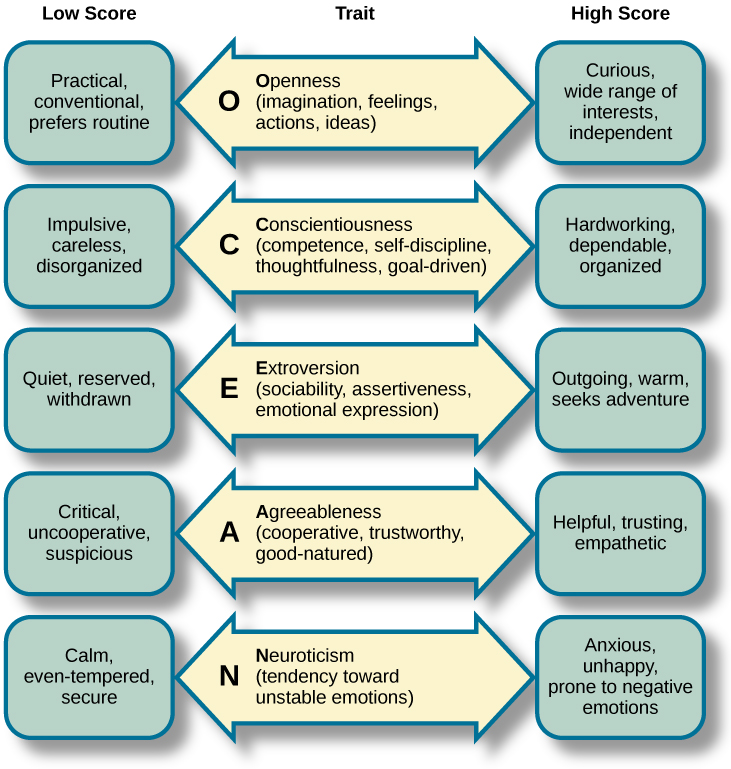Personological Trait Theory Basic Assumptions. The trait approach to personality psychology best describes what situation.

The Social And Personality Psychology Domain Introduction To Psychology
Eysenck Eysenck 1985.

. The trait approach to personality psychology best describes what situation. A A psychologist studying the ways in which people alter their behaviors because of rewards or punishments b A psychologist focusing on ways that people differ from one another in behavior and disposition and how these differences might be measured. Traits in psychology refer to the ways in which we generally describe a person.
Situation versus personality. Facets Broad personality traits can be broken down into narrower facets or aspects of the trait. The descriptive terms such as out-going short tempered generous are all traits.
The work of both Eysenck and Mischel was crucial in forming what became a massive debate in psychology. Personalities are made up of these traits which are assigned to individuals to show how they differ from others. Cats for instance have dispositions to hiss and scratch but will only express these.
In the five factor model each person has five traits Openness Conscientiousness Extroversion Agreeableness Neuroticism which are scored on a continuum from high to low. A trait is a dimension of personality which can be measured and must describe the consistent behaviour of an individual. Psychology questions and answers.
They are displayed on a dimension or spectrum. The trait approach to personality psychology best describes what situation. The idea expressed by Hippocrates and Galen that human personality can be categorized into distinct types survived through the centuries and served as the basis for trait theory.
We might think of the dimensions as super factors Eysenck 1990a 1990b. A trait in order to be a meaningful measure of the human personality must be a distinctive and enduring. Mischels particularly as it made many psychologists ask what was the point of studying personality if it predicted so little.
The structure of personality. A Psychologist focusing on ways that people differ from one another in behavior and disposition and how these differences might be measured. Using language traits describe peoples objective behaviors.
A psychologist trying to understand personality in terms of anatomy physiology inheritance and evolution B. Trait Measures Do Not Predict Behavior Well Person-by-situation approach Prediction of behavior is better when looking at trait score and situation Trait scores rarely correlate with behavior above 30 or40 Personality coefficient 10 of variance. The trait approach to psychology best describes what situation.
This 2500 year history is an enormously long-lasting example of. Traits manifest themselves in a variety of functionally. For example extraversion has several facets such as sociability dominance risk-taking and so forth.
What Is The Trait Theory of Personality. A psychologist studying the ways in which people alter their behaviors because of rewards or punishments a psychologist focusing on ways that people differ from one another in behavior and disposition and how these differences might be measured. Personality does not change much over time D.
A personality trait that reflects a persons tendency to be sociable outgoing active and assertive. A trait as a dimension is conceived quantitatively as a continuous scale of measurement from extensive positive end to the extreme negative end. Three Dimensions of Personality or Eysencks Trait Theory of Personality.
A psychologist studying the role of gene expression in babies children and young adults. The Big Five Personality Traits. Emphasize individual differences in characteristics that are stable across time and situation Emphasize measurement of these traits through tests We do not see traits we infer them from consistencies in peoples behavior.
In the center column notice that the first letter of. People behave differently in different situations B. That is a trait is best thought of as a probabilistic tendency that a person has to act in a certain way when placed in a certain kind of situation.
The result of their efforts is a personality theory based on three dimensions defined as combinations of traits or factors. People behave similarly in different situations C. Traits describe stable consistent and meaningful differences among individuals.
The trait approach to personality assumes that A. Gordon Allport 1937 a pioneer of trait theory in psychology proposed that personality psychology aims to construct an overall and coherent picture of an individual that determines the core psychological processes and also shows the extent of similarity and difference with other individuals. Traits can be defined as a stable characteristic that causes a person to depict a response to.
The five factor model introduced by McCrae and Costa in 2008 proposes that our behavior is measured across the five personality traits of extroversion neuroticism conscientiousness openness and agreeableness. Trait approach is one of the most vital areas of study in psychology that helps identify a persons personality. Typically people who are extroverted are assertive and excitement seeking.

Trait Theories Of Personality Psychology

0 Comments